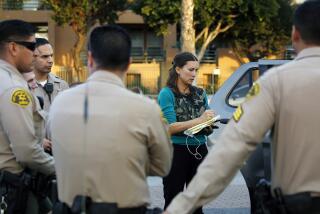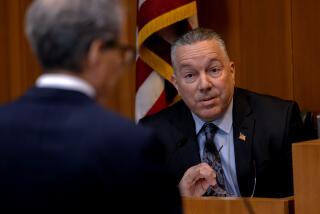L.A. County sheriff to turn over Ruben Salazar files to watchdog agency
Los Angeles County Sheriff Lee Baca said Wednesday that he would turn over thousands of pages on the slaying of former Times columnist and KMEX-TV News Director Ruben Salazar to the civilian watchdog agency that monitors the Sheriff’s Department so a report can be prepared on the 40-year-old case.
Baca’s move comes in response to a California Public Records Act request filed by The Times in March seeking records that might shed light on Salazar’s killing by a deputy after rioting exploded in East Los Angeles during the National Chicano Moratorium Against the Vietnam War. Questions and controversy continue to cloud the Aug. 29, 1970, slaying.
Baca spokesman Steve Whitmore said the sheriff will publicly release the report by the county Office of Independent Review and use the findings to determine whether he will unseal any of the eight boxes of files.
Baca initially denied the Times’ request, but then last week said he would proceed with a review. That decision came on the same day that Supervisor Gloria Molina introduced a motion ordering a report from county attorneys on releasing the records.
“This is a process that the sheriff wants to take so he can begin to show the public we have nothing to hide,” Whitmore said. “The sheriff wants to move this forward.”
Lisa Salazar Johnson, one of Salazar’s daughters, praised Baca for taking action but said all the documents should be unsealed.
“I feel they should be made public so everyone can draw their own conclusions,” she said.
Supervisor Mark Ridley-Thomas also lauded Baca for his decision but said he supported releasing the records. “This is not meant to reflect poorly on the current sheriff or the department as a whole,” he said. “It is to capture the significance of our history for our collective benefit and our posterity.”
The records include photographs, investigative reports and notations, Whitmore said.
If there is sufficient information in the material, the Office of Independent Review will assess the actions of the department and deputies involved in Salazar’s death and compare them with current policies and procedures, Director Michael Gennaco said.
“We’re going to let the chips fall where they may,” said Gennaco, whose staff includes about half a dozen attorneys who monitor officer-involved shootings and allegations of wrongdoing. “Maybe there’s answers in those boxes.”
Salazar was struck in the head by a 10-inch, torpedo-shaped tear-gas projectile fired by a deputy. The newsman was inside the Silver Dollar bar on Whittier Boulevard, where he and a KMEX reporter had been taking a break from covering the action.
It was never determined whether the deputy was following department policy when he fired the missile, which bore the warning: “Not to be used against crowds.” During a 16-day coroner’s inquest, the hearing officer twice refused to subpoena the sheriff’s manual covering the use of tear gas, saying the document was classified.
Deputies testified that they warned people to get out of the bar after receiving reports of an armed man inside. But four men who had been inside told the inquest panel that they had been forced back into the bar by deputies moments before the fatal projectile was fired. No armed man was ever found inside the small tavern.
The inquest concluded that Salazar “died at the hands of another,” a ruling that confused observers and angered Mexican American activists, who said the hearing focused on the actions of the rioters but failed to investigate what happened in the moments leading up to the killing.
“It was a whitewash,” said Joe Rank, a former KMEX vice president who hired Salazar to head the station’s news department.
robert.lopez@latimes.com
robert.faturechi@latimes.com
More to Read
Sign up for Essential California
The most important California stories and recommendations in your inbox every morning.
You may occasionally receive promotional content from the Los Angeles Times.












